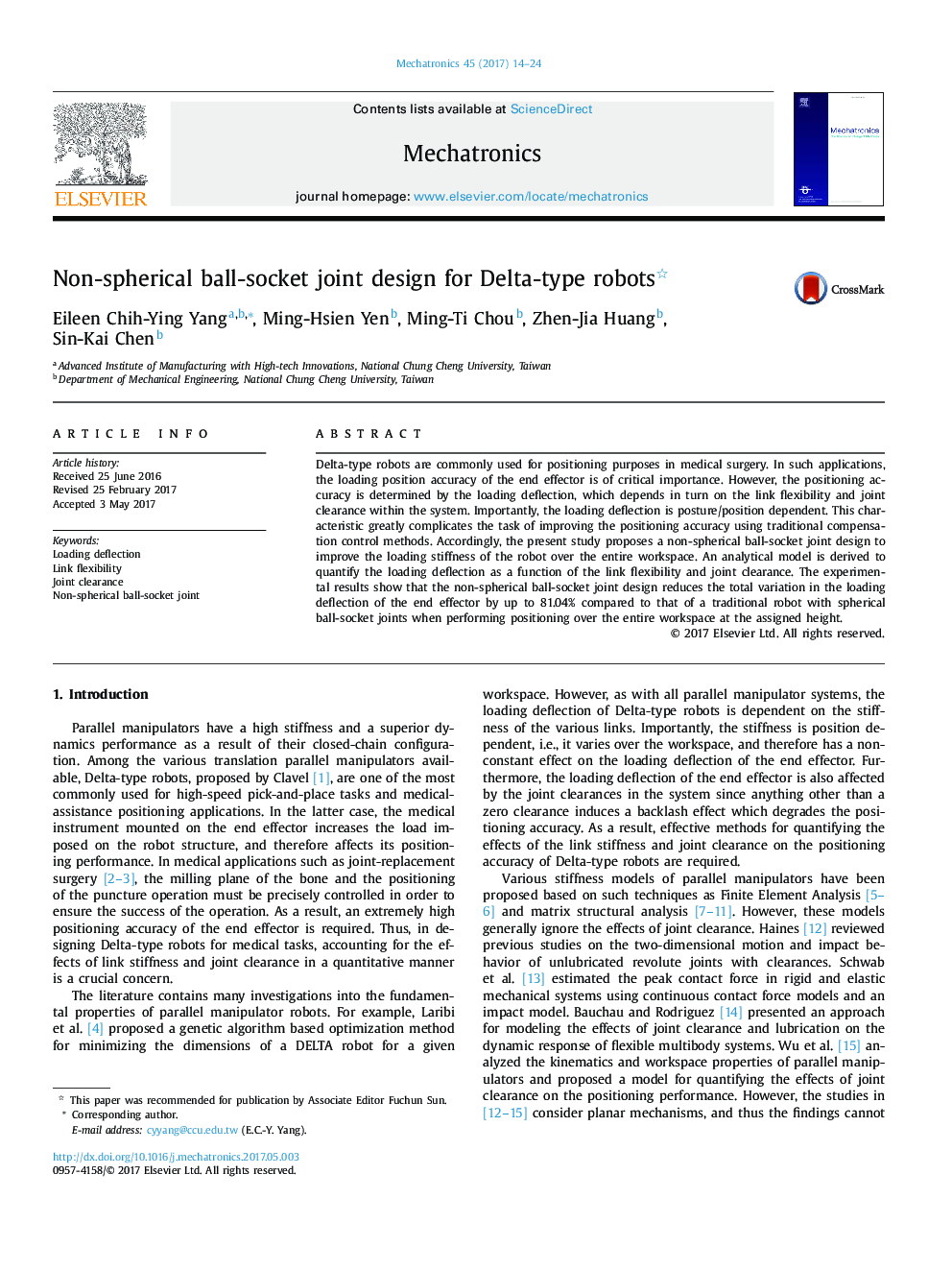| کد مقاله | کد نشریه | سال انتشار | مقاله انگلیسی | نسخه تمام متن |
|---|---|---|---|---|
| 5007027 | 1461555 | 2017 | 11 صفحه PDF | دانلود رایگان |
عنوان انگلیسی مقاله ISI
Non-spherical ball-socket joint design for Delta-type robots
ترجمه فارسی عنوان
طراحی کروی غیر کروی توپ-سوکت برای روبات های نوع دلتا
دانلود مقاله + سفارش ترجمه
دانلود مقاله ISI انگلیسی
رایگان برای ایرانیان
کلمات کلیدی
انحراف بار، انعطاف پذیری لینک تمیزکاری مشترک، غیر کروی توپ مشترک سوکت،
ترجمه چکیده
روباتهای دلتا معمولا برای اهداف موقعیت در جراحی پزشکی استفاده می شوند. در چنین کاربردی، دقت موقعیت موقعیت بارگذاری در نتیجه عملگر بسیار مهم است. با این حال، دقت موقعیت توسط انحراف بار تعیین می شود، که به نوبه خود در انعطاف پذیری لینک و ترخیص مشترک در داخل سیستم بستگی دارد. مهم است که انحراف بار، موقعیت / موقعیت وابسته است. این ویژگی به وضوح با استفاده از روش های کنترل گرانروی سنتی کار بهبود دقت موقعیت را پیچیده می کند. بر این اساس، مطالعه حاضر پیشنهاد می دهد طراحی مشترک مشترک از نوع غلاف کروی برای بهبود سختی بارگیری ربات در سراسر کل فضای کاری. یک مدل تحلیلی برای اندازه گیری انحراف بار به عنوان یک تابع از انعطاف پذیری لینک و ترخیص مشترک است. نتایج تجربی نشان می دهد که طراحی مشترک مشترک غیر کروی توپ-سوکت، تغییرات کلی در انحراف بار سازنده پایان را تا 81.04٪ نسبت به ربات سنتی با مفاصل سوپاپ-کروی کاهش می دهد در حالی که موقعیت در طول کل فضای کاری در ارتفاع تعیین شده.
موضوعات مرتبط
مهندسی و علوم پایه
سایر رشته های مهندسی
کنترل و سیستم های مهندسی
چکیده انگلیسی
Delta-type robots are commonly used for positioning purposes in medical surgery. In such applications, the loading position accuracy of the end effector is of critical importance. However, the positioning accuracy is determined by the loading deflection, which depends in turn on the link flexibility and joint clearance within the system. Importantly, the loading deflection is posture/position dependent. This characteristic greatly complicates the task of improving the positioning accuracy using traditional compensation control methods. Accordingly, the present study proposes a non-spherical ball-socket joint design to improve the loading stiffness of the robot over the entire workspace. An analytical model is derived to quantify the loading deflection as a function of the link flexibility and joint clearance. The experimental results show that the non-spherical ball-socket joint design reduces the total variation in the loading deflection of the end effector by up to 81.04% compared to that of a traditional robot with spherical ball-socket joints when performing positioning over the entire workspace at the assigned height.
ناشر
Database: Elsevier - ScienceDirect (ساینس دایرکت)
Journal: Mechatronics - Volume 45, August 2017, Pages 14-24
Journal: Mechatronics - Volume 45, August 2017, Pages 14-24
نویسندگان
Eileen Chih-Ying Yang, Ming-Hsien Yen, Ming-Ti Chou, Zhen-Jia Huang, Sin-Kai Chen,
